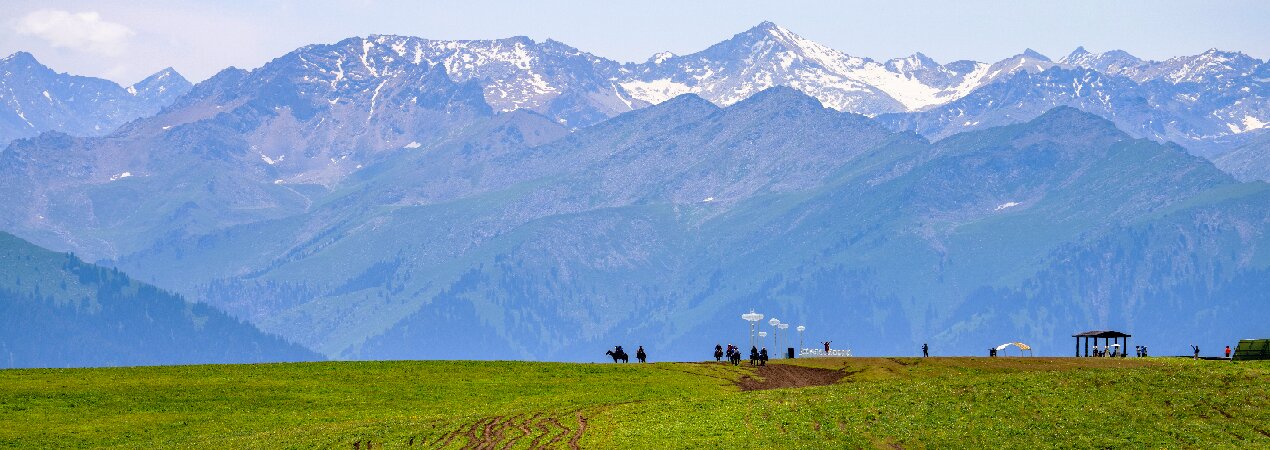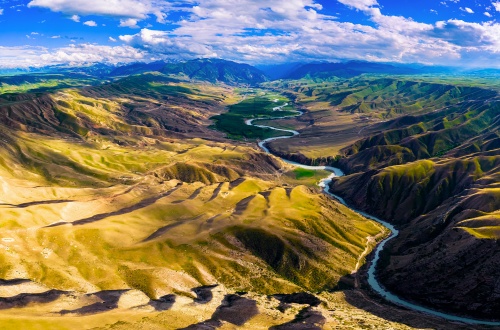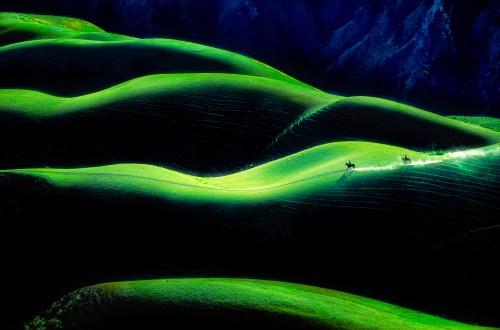Kalajun Grassland

Kalajun Grassland in Xinjiang is located in Tekes, the famous Eight-Diagram City, in the Ili River Valley. It covers an area of nearly 3,000 square kilometers, with an altitude ranging from 1,305 meters to 3,957 meters. Renowned for its primitive ecology and alpine meadow landscapes, it is hailed as the "Flower Grassland Suspended in the Air". Kalajun Grassland is very large and is divided into East Kalajun, West Kalajun and Kuokesu Grand Canyon Scenic Area.
- Chinese name: 喀拉峻草原 Kā Lā Jùn Cǎo Yuán
- Suggested time: 1 - 2 days
- Ticket: 140 yuan or more
- Open hours: 07:30 - 22:00 (Admission stops after 19:30)
- The best time to visit: From mid - May to late August
- Address: In Tekes County, Ili Kazakh Autonomous Prefecture, Xinjiang Uygur Autonomous Region. The specific location is the transition zone from the Western Tianshan Mountains to the Ili River Valley.
- How to get there: It is recommended to reach the scenic area by self-driving. Then, purchase a self-driving ticket for the scenic area, and you can enjoy the scenery by driving around inside the scenic area.
Highlights of Kalajun Grassland
East Karajun Grassland and West Karajun Grassland
The East and West Karajun Grasslands form the core area of Karajun Grassland, which is divided into West Karajun and East Karajun.
The West Karajun Scenic Area mainly includes such attractions as Wangyutai (Jade-Viewing Platform), Marmot Habitat, Liangyitai, Dielanggu (Wavy Valley), Shiquan (Stone Spring), Yinmawan (Horse-Drinking Bay), and Yikeshu (One Tree). Among them, Dielanggu is a typical hilly grassland. In summer, layers of green roll out like waves, making it an excellent spot for photography.
East Karajun is the essence of the entire grassland, featuring attractions like Wuhuacaodian (Five-Flower Meadow), Xianhuatai (Flower Platform), Kuerdai Forest Grand Canyon, Sanji Yipingmian (Triple Planation Surface) Viewing Platform, and Lieyingtai (Falcon Platform) Viewing Point. Wuhuacaodian bursts into a sea of flowers from May to July, while Xianhuatai offers a perfect view of grassland flower seas set against snow-capped mountains in the same frame.
Koksu Grand Canyon
 Crocodile Bay
Crocodile BayThe Koksu Grand Canyon Scenic Area is one of the core attractions among the four major scenic zones in the Karajun tourist area. Its landscape features are mainly dominated by canyon landforms, water landscapes, and alpine grasslands, integrating high-gorge flat lakes, snow-capped mountain peaks, primeval vegetation, steep cliffs, streams, and exotic rocks. Among them, Crocodile Bay is located in the middle of the Koksu Grand Canyon Scenic Area. It gets its name because the mountain resembles two crocodiles lying at the bottom of the valley, and it is a famous attraction in the Koksu Grand Canyon Scenic Area. The valley is deep with steep cliffs, and the river water can appear in colors such as milky white, turquoise, and emerald green.
 Nine-Bends and Eighteen-Twists
Nine-Bends and Eighteen-TwistsThe beautiful Koksu River winds and twists, with steep banks and dangerous terrain, forming natural landscapes such as the Hukou Waterfall, the Nine-Bends and Eighteen-Twists, and Crocodile Bay. The Nine-Bends and Eighteen-Twists is situated in the Koksu Grand Canyon Scenic Area. Standing on Muyun Terrace and looking down, the river course is like a dragon coiling in the canyon, presenting a breathtaking scene. In addition, the canyon cable car is also quite distinctive. When crossing the canyon, one can enjoy the river water showing different colors such as emerald green and amber gold as the light changes.
 "Human Body Grassland"
"Human Body Grassland"The "Human Body Grassland" is located in the Koksu Grand Canyon area. Also known as the Nude Island, it lies to the west of the viewing point of the Nine-Bends and Eighteen-Twists. The naturally formed gullies on the grassland hills are like the soft curves of a woman's body, thus earning it the reputation of the most beautiful "Human Body Grassland". Flocks of sheep and horses run on the grassland, forming a stunning landscape together with the beautiful "human body" shape of the grassland.
Educational Value
The Ili River Valley, where Kalajun Grassland is situated, lies in the hinterland of the Tianshan Mountains. It is the product of the combined effects of plate movement, glaciation, and river erosion. Landforms in the grassland—such as hills, canyons (e.g., the Koksu Grand Canyon), and planation surfaces—have fully preserved the evolutionary traces of different geological periods. These features serve as important evidence for studying regional crustal uplift and changes in the erosion base level, and provide a natural teaching case for research into geographical theories.
Activities to do at Kalajun Grassland
Sightseeing and Photography: The Nine-Bends and Eighteen-Twists in the Koksu Grand Canyon is an excellent spot for capturing sunsets; the curves of the "Human Body Grassland" shift dramatically under light and shadow, making it a must-photograph location for photography enthusiasts.
Horseback Riding: Horseback riding across the vast grassland is a classic activity. Under the guidance of herdsmen, tourists can ride at a leisurely pace or gallop freely, savoring the grassland’s vastness and sense of freedom.
Ecological and Scientific Expeditions: Boasting rich flora and fauna as well as unique landforms, the grassland supports investigative research in fields such as ecology and geology, helping to deepen understanding of the grassland ecosystem’s functioning and geological evolution processes.
Drop us a line and we'll connect you with the top China expert in no time!